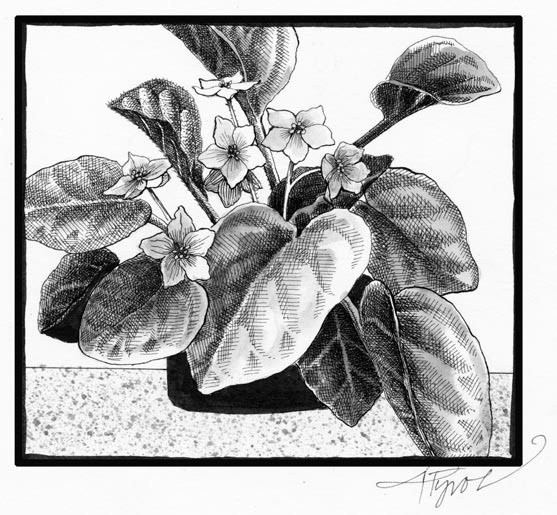
It was with uneasiness that I accepted the little African violet a friend gave me for my birthday a few years ago. I had never had any luck growing the cute little furry things. To my dismay, whenever an African violet (Saintpaulia ionantha) crossed my threshold, it would quickly shrivel up, turn brown, and die. I decided to give this one away as soon as possible.
African violets aside, my house is full of big, healthy, happy houseplants. I have at least twenty-five different species on my windowsills. I carry on an ancient tradition: humans have been growing houseplants since the times of the Egyptians.
When plants were first brought inside, our houses were dark, dank, and poorly heated. These conditions favored species from the shady, humid floors of tropical rain forests. Many of our indoor ferns come from these habitats. The peace lily (Spathiphyllum wallisii), with its beautiful flower looking like a pure white Jack-in-the-pulpit, was found in the rainforests of Columbia.
Over the years, advances in home technology – plumbing, heating, windows – have transformed our houses – and our house plants. Modern homes with their warmer, sunnier, dryer conditions favor plants from the deserts and the grasslands – places where water is scarce, the air is dry, and the growing conditions are harsh – just like the microclimate in our homes.
Most of the cacti in my home are from the American deserts. My crown-of-thorns (Euphorbia milii) is from the hot, dry lands of Madagascar. My nearly immortal spider plant (Chorophytum comosum) is native to the dry grasslands of South Africa. My fleshy jade plant (Crassula ovata) is from the dry scrub and bush lands of South Africa. My aloes are from the dry, rocky bush lands of South Africa and Madagascar.
Epiphytes are also well adapted to our homes, and many are among our favorite houseplant species. Epiphytes grow with their roots high above the ground, taking advantage of the vertical layers in the tropical forest to gather more sunlight and real estate. They sprout in debris lodged in the bark and branches of the trees. My Thanksgiving cactus (Zgocactus truncatis) is an epiphyte from Brazil that lives high up in the rainforest trees of the Amazon.
My ficus or weeping fig (Ficus benjamina), a miniature tree with graceful weeping branches and numerous two-inch long, lance- shaped leaves, is native to the humid tropical forests of south and south-east Asia and Australia. In the wild the ficus is a “strangler fig,” beginning its life as a small epiphyte sprouting in the top of a tree, perhaps from a seed dropped by a bird. As it grows, it sends out roots that cling to the host tree’s branches and eventually reach the forest floor, where they grow larger and wrap themselves around the tree and eventually strangle it. Luckily, when grown inside in a pot, the ficus abandons it murderous ways.
The African violet is a relative newcomer to the home. The fuzzy little plant with purple blue flowers was discovered in 1892 in northern Tanzania by Baron von St. Paul-Illaire, who was governor of the area. Today the African violet is one of the most popular houseplants in the Western world, perhaps the most popular. We have crossbred it to create thousands of varieties in a multitude of colors and forms.
Nevertheless, I decided to give away the little African violet to save its life. In the meantime, I tucked it in on my living room windowsill with some other houseplants. Except for watering it occasionally, I paid it no attention – and I forgot to give it away.
One day I noticed a patch of violet blue peeking out from underneath the larger plants. It was the African violet. To my surprise the little plant had survived. Over the coming months, it grew bigger and continued to push up masses of little frilly purple blossoms. This summer, it had gotten so big that I spit the plant into two.
By tucking the violet under the shade of my other houseplants, it seems I had inadvertently discovered how best to care for it. In its native habitat, the African violet grows in the shade on the sides of steep rocky banks. There it clings to patches of dirt in crevasses and depressions, growing sideways out of the wet but well-drained soil. Nevertheless, it has adapted to growing upright in pots inside our homes.
While the African violet thrives and multiplies in nurseries and on window sills across the world, it is in deep trouble in its native home. Today it holds out in only one small area, the Usambara Mountains of far northern Tanzania. Intense farming and logging pressures are causing those forests to disappear.
One day the African violet may be found only on our windowsills.

